EA Survey 2019 Series: Geographic Distribution of EAs
By Neil_Dullaghan🔹 @ 2020-01-22T14:44 (+43)
Summary
- 74% of EAs in the survey currently live in the same set of 5 high-income English-speaking western countries as in 2018.
- The share of EAs living outside of the USA and Europe is slightly larger (4%) than in 2018 and larger among newer EAs than veteran EAs.
- 40% of EAs live in cities with fewer than 10 other fellow EAs.
- While Global Poverty is a high priority cause area for EAs around the world, EAs in the USA appear to prioritize Cause Prioritization less than their peers elsewhere and EAs outside the USA and Europe appear to prioritize Climate Change more.
- When pressed to choose only one of the traditional broad cause areas of EA (Global Poverty, Animal Welfare, Meta, Long Term Future, Other) the Long Term Future/Catastrophic and Existential Risk Reduction is the most popular among EAs in the USA and Europe.
- EAs living outside of the USA and Europe reported the largest shares of non-engaged or only mildly engaged EAs, possibly stemming from their obstacles to participating in “high engagement activities”.
This post is part of Rethink Charity's series on the EA Survey 2019, which provides an annual snapshot of the EA community. In this report, we explore the geographic distribution of EAs in the survey. We have already explored demographics, cause prioritization and careers and skills. In the future, we will explore how these EAs first heard of and got involved in effective altruism and their donation patterns.
Introduction
Effective Altruism is a global movement. There are local EA groups in approximately 45 countries,[1] EA Global and EAGx conferences have been held in 9 countries across 5 continents,and many EAs are keen to build a framework for developing EA in emerging locations. The survey data does not allow us to reveal the citizenship or place of birth of EAs, but we can see where they reported currently living when the survey was conducted (September-October 2019). The geographic distribution of EAs is likely due to a combination of where the movement has been best at recruiting but also where EAs, who are disproportionately a young, white, male educational elite, are most likely to have moved to. While EAs in this year’s survey reported living in 60 different countries,[2] respondents continue to most often be currently living in English speaking countries, especially the USA and UK (see here and here for discussions about the dominance of English in EA).
Global distribution of EAs
The countries EAs most commonly report living in remained mostly unchanged from last year. 55% of EAs in the survey live in the USA or UK, 24% in the rest of Europe, 10% in Australia or New Zealand, and 4% in Canada. The share of EAs living outside of the 5 top countries (USA, UK, Germany, Australia, Canada) has increased by 4% (from 22% to 26%) compared to 2018’s survey sample.


N.B. images can be viewed in full size if opened in a new tab.
 1.4% of EAs live in global population hubs China and India, which is even more than in the entire continents of Africa or South America (~1% each), but the same percentage as live in comparatively smaller Sweden. Looking at the number of EAs living in a country relative to the total population of that country gives us some indication of the saturation EA has reached there. New Zealand, Norway, Australia, the UK, and Switzerland make up the top 5 on this measure.
1.4% of EAs live in global population hubs China and India, which is even more than in the entire continents of Africa or South America (~1% each), but the same percentage as live in comparatively smaller Sweden. Looking at the number of EAs living in a country relative to the total population of that country gives us some indication of the saturation EA has reached there. New Zealand, Norway, Australia, the UK, and Switzerland make up the top 5 on this measure.

For ease of comparison we highlight only the top EA countries by absolute number of EAs. Although the absolute number of EAs per countries is down across the board due to a smaller sample this year, New Zealand clearly stands out due to having double the number of EA respondents reporting living there compared to 2018. The jump in EAs per capita is partly due to New Zealand having a relatively small population, however, even if there were 25 fewer EAs in New Zealand it would still lead this table, so higher recruitment might also play a role. Like last year, we see data that suggests that the UK has a large number of EAs per capita comparable to countries with much smaller total populations.
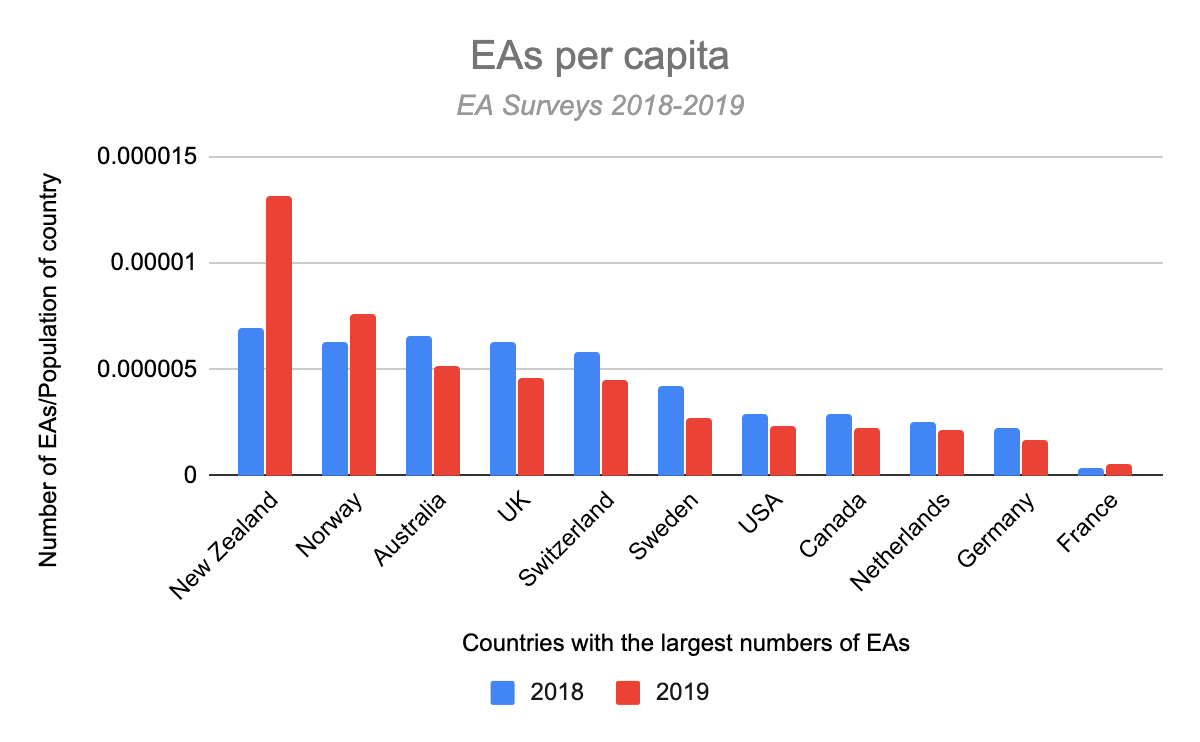
EAs in each city
The most commonly reported city an EA lived in was the San Francisco Bay Area (with 9% of respondents) followed by London (7%) and New York City (5%), though there was an extremely long tail of smaller cities and Other responses. [3] In the figure below it is clear that the number of EAs in the top “major hubs” is dwarfed by the number of EAs in “Other” cities which are not named in the figure below due to having fewer than 10 EAs.

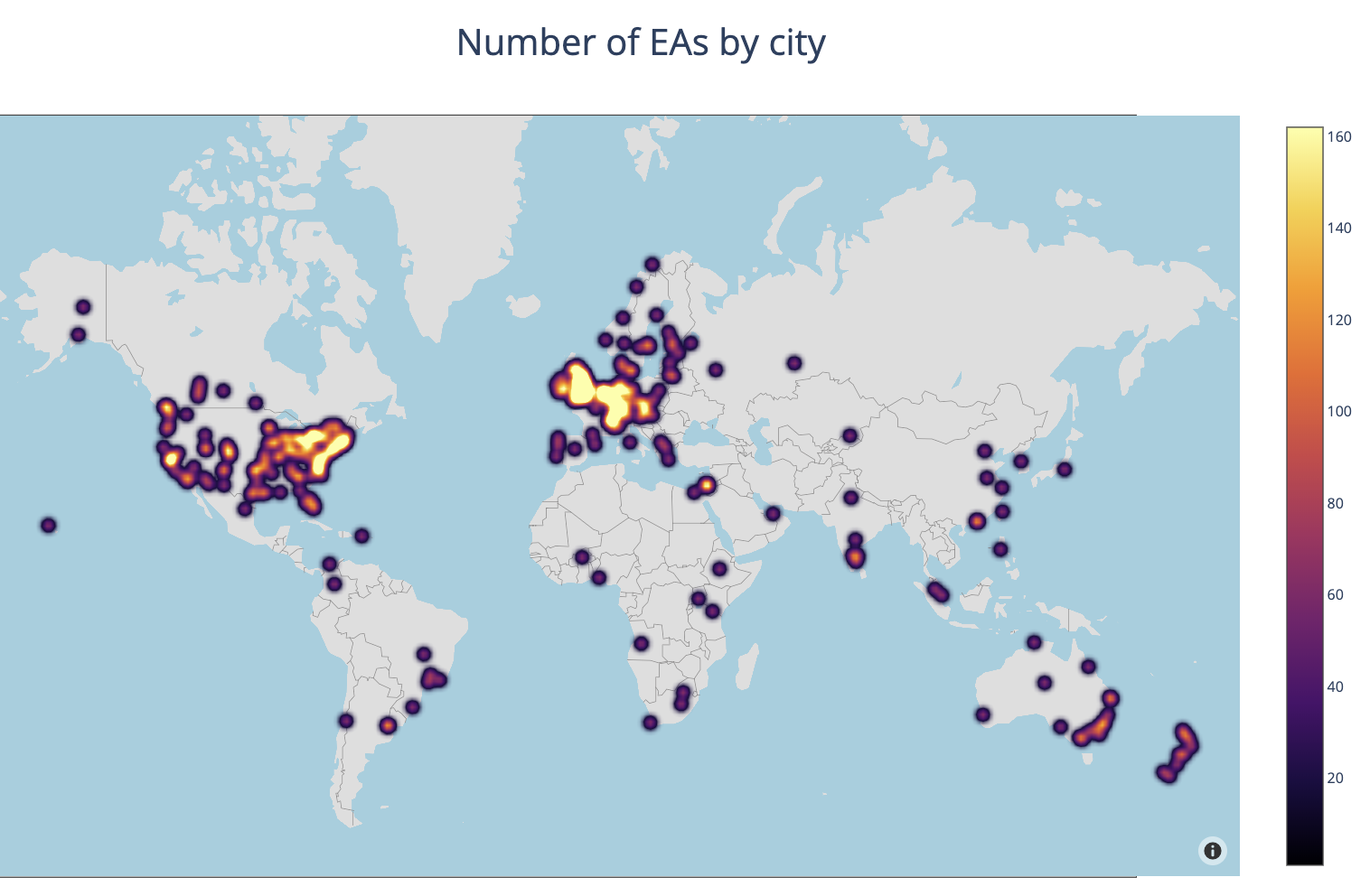
In the next figure only the 10 largest hubs are highlighted for easier comparison.

We then examined the number of EAs in a city relative to the population of those cities. Looking only at those cities with 10 or more resident EAs, university cities Oxford and Cambridge led the list, followed by Blackpool presumably in part because of the EA hotel. We should also note that the San Francisco Bay Area has a large number of EAs (even for the size of the total metropolitan area), as does London.

EA growth over time
For the remainder of this report we group the country data into the broad geographical categories of USA, UK, Other Europe and Rest of the World as these offer more comparable group sizes. The share of EAs living in the USA declines by years a respondent has been in EA. Again we should remind the reader that the data reflects where EAs currently live and neither their nationality nor where they lived when they joined EA necessarily. Those who have been in the movement the longest are most likely to currently live in the USA and UK, however a majority of the newest EAs live outside of these two countries.
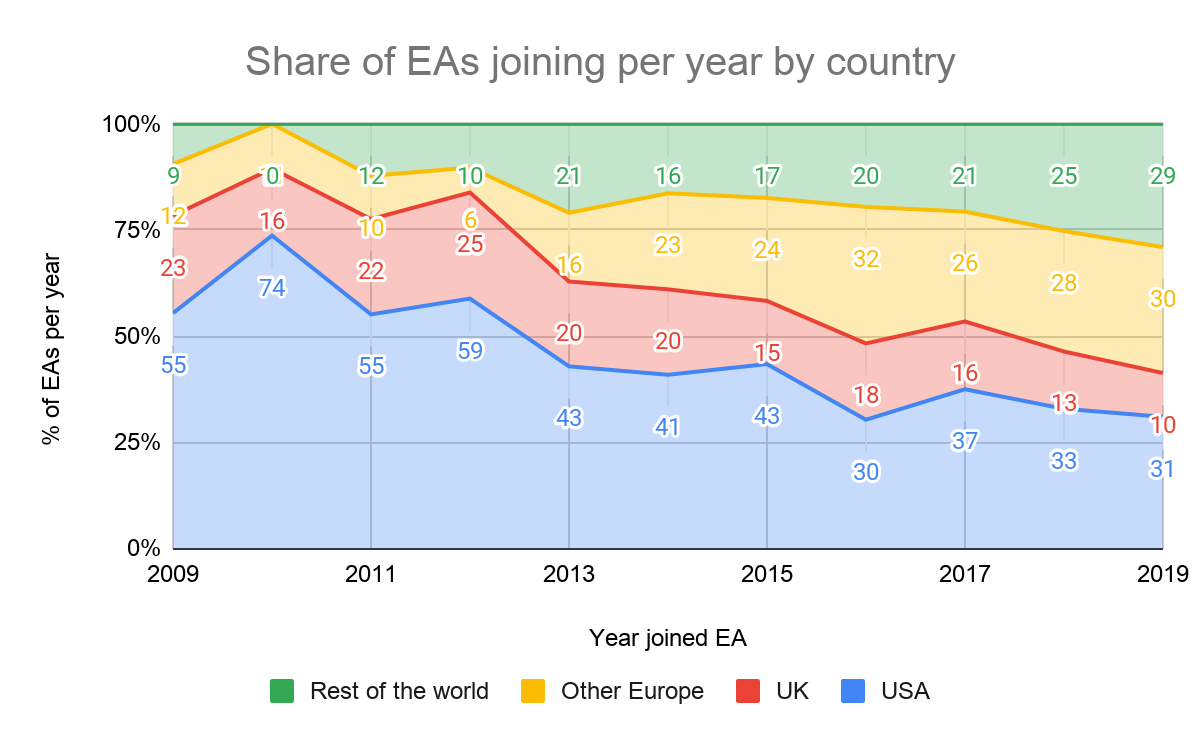
We also see some evidence of a plateau or even decline in the absolute number of EAs living in the UK and the rest of Europe who joined after 2016.

One reason to be more tentative about these possible shifts is that we only have survey results from those who have remained in EA since they joined, and we do see some differences from the results of 2018’s EA survey. For example, far fewer EAs in the 2019 survey reported having joined EA between 2015 - 2017 than did so in the 2018 survey, and this trend appears across countries. This could be a sign that many EAs drop out within 1-3 years of first involvement, while those who have been engaged 5 or more years rarely drop out. Running a few more years of the EA survey may allow us to find out if this is the case.
EA engagement
The survey included a question asking EAs to report their level of engagement in EA on a 5 point scale of No Engagement to High Engagement.[4] EAs living in the UK had the largest share reporting to be highly engaged (31%). Meanwhile, EAs living outside of the USA and Europe reported the largest shares of non-engaged or only mildly engaged EAs. The self-reported engagement scale offered descriptive criteria for each level, some of which people living outside “core” geographic areas may find it harder to do. For example, they might find it harder to attend an EAG or work at an EA organization, even if they are maximally engaged otherwise.

It looks like EAs living in the USA are pluralities in each engagement group except those not engaged in EA (where EAs living outside of the USA and Europe are the largest group). EAs living in the USA and UK make up 60% of highly engaged EAs.

Of the three online groups the EA survey asked about, 43% to 60% of EAs in each region were members of the EA Facebook page, while fewer than a quarter were members of LessWrong. 24%-38% of EAs in each region were members of the EA Forum. Local group membership was especially high among EAs living in Europe. This is not surprising given that 50% (88/176) of groups are in Europe, and continental Europeans were more often local group members in last year’s survey too. Less than half of EAs in each region were GWWC members. GWWC membership is highest among EAs living in the UK (43%) where the organization began and where EAs tend to be more involved in groups in general.


Careers
The most popular career paths that effective altruists in the survey plan to follow are in earning to give roles (38%) and working at EA organizations (37%). The survey allowed respondents to select multiple career paths they plan to follow. Earning to give is even more popular among EAs living in the USA (41%) and less so in the UK, where only 26% of EAs reported pursuing this career path. EAs in the UK instead were more likely to select planning to work at an EA organization (48%). EAs living elsewhere in Europe were most likely to choose academia (39%). We have already highlighted elsewhere how the skills most needed by EA are spread geographically.

Looking at the data by city corresponds to many prior assumptions. EAs living in Oxford and London are most likely to be on the working at an EA organization career track. EAs living in Washington DC are most likely to be on the working in government career track. EAs in the San Francisco Bay Area appear equally split (noting again that EAs could select multiple options) between pursuing career paths in earning to give and working at an EA organization.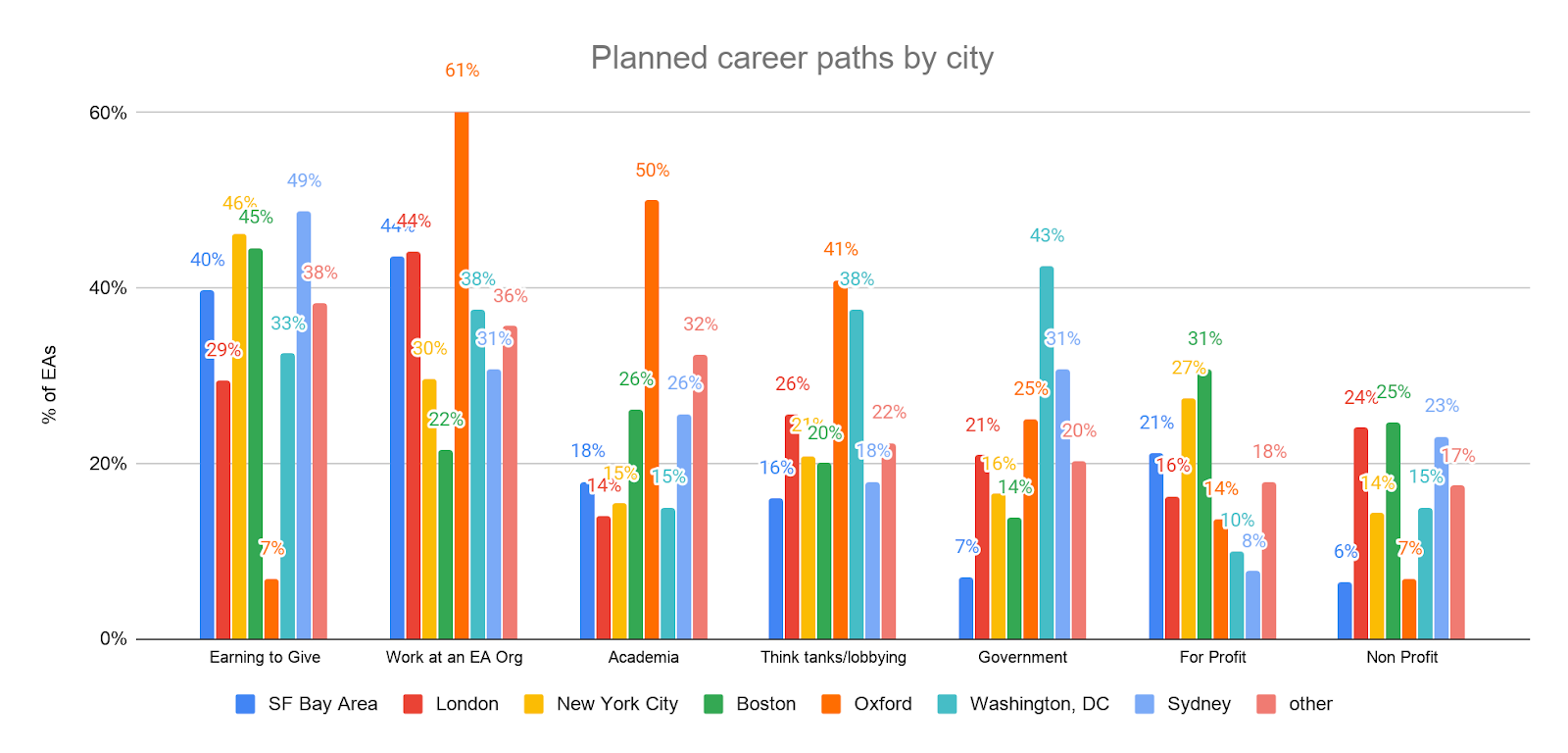
296 (15%) EAs in the survey currently or previously worked at an EA organization. This share is even higher among EAs living in the UK (24%) and USA (17%), which is unsurprising given how many EA organizations are based there. Meanwhile, only 7% of EAs living outside of Europe or the USA currently work or previously worked at an EA organization.

Political affiliation
We have shown elsewhere that most effective altruists are on the Left or Center Left, and there is interest in how Effective Altruists can be welcoming to conservatives, specifically Republicans. Depending on the country, the meaning of Left and Right can vary, or not even be a salient political dimension. We should once again highlight that our data only shows where an EA lives and so an EA reporting both living in the USA and being on the Right-hand side of the political spectrum does not mean they are a registered Republican for example. Over 75% of EAs in all major regions reported being on the Left or Center Left. 3% of EAs living in the USA reported being affiliated with the Right or Center Right. We can also see that the share of EAs affiliated with Libertarianism is highest among EAs living in the USA.

Gender
Like the EA survey as a whole, there are more male than female EAs across each region and major EA metropolitan hub.[5]


Veg*n status
Those who eat meat and those that abstain from eating meat are present in roughly equal amounts overall in the survey. 46% claim to be vegan or vegetarian, while 48% consume meat of some form. 58% of EAs living in the USA eat meat of some form, though 35% are trying to reduce meat consumption and 6% are pescatarian. Rates of veg*nism are highest among EAs who live in Europe (59% in the UK and 60% elsewhere in Europe). EAs living outside of Europe and the USA more closely resemble EAs in the USA in terms of dietary preferences.

Oxford and London have the highest percentage of veg*nism among the major EA metropolitan hubs and Boston and Washington DC had the highest percentage of EAs who don’t report reducing or restricting their meat consumption in any way.

Cause prioritization
The top five causes, as ranked by EAs in the survey, are Global Poverty, Cause Prioritization, AI Risk, Climate Change, and Biosecurity in that order. We can clearly see in the table and figure below of the mean ratings of cause areas (ranging from (1) this cause should not receive any resources to (5) this cause should be the top priority)[6] that EAs living outside of the USA appear to give more priority to Cause Prioritization than EAs in the USA. EAs living outside of the USA and Europe appear to favour Global Poverty and Climate Change more than those living in these regions. This may be related to newer EAs tending to live outside of these regions and also tending to prioritize different causes than veteran EAs, although it is unclear how strong this association is. 
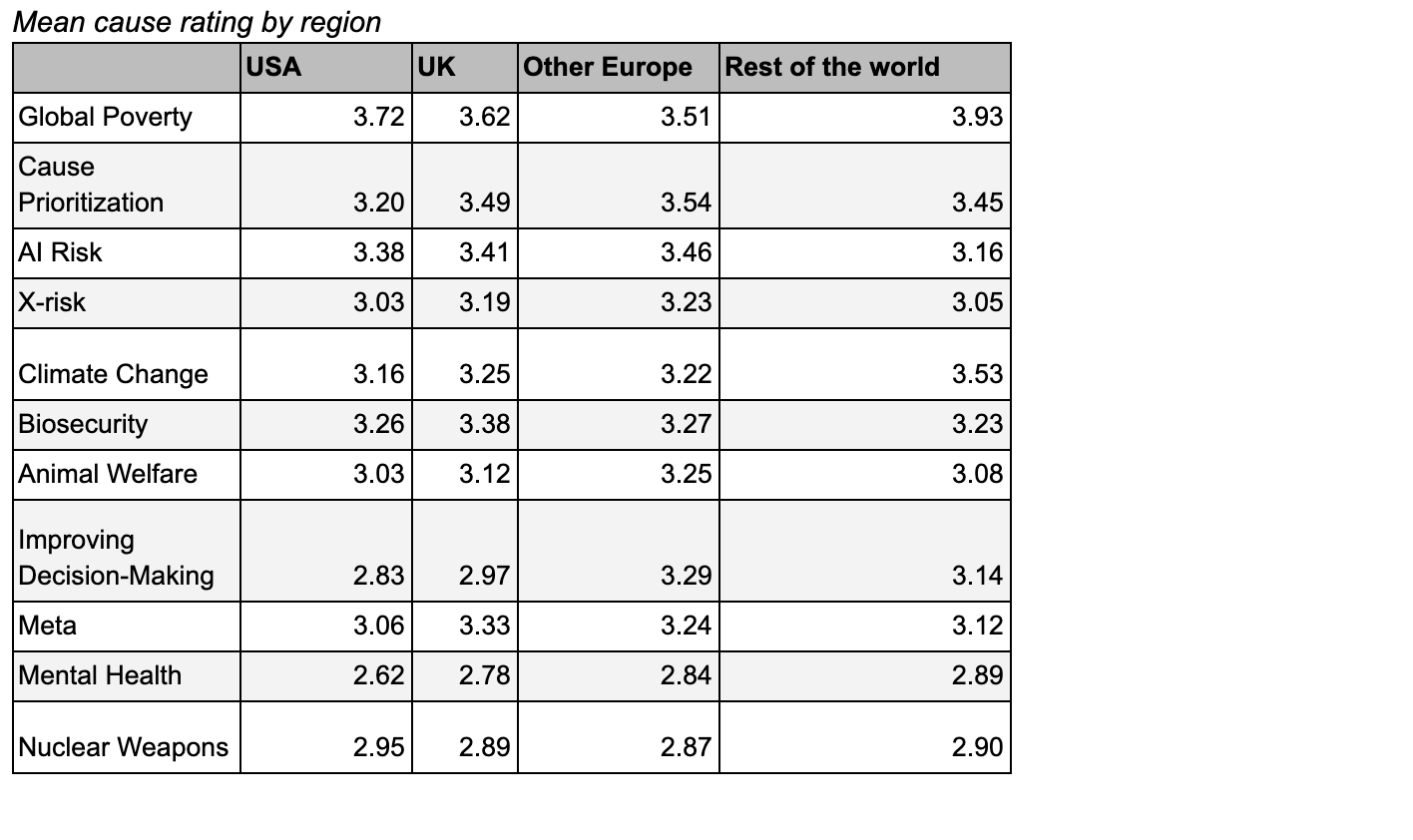
The top two causes were Global Poverty and Climate Change among EAs living in New York City, Boston, and Sydney. Global Poverty and Cause Prioritization were the most popular cause areas among EAs in London and Washington, DC (the latter also prioritizing Biosecurity very highly). EAs in the San Francisco bay area tended to prioritize AI Risk and Global Poverty the most, while EAs in Oxford prioritized Cause Prioritization and AI Risk/Biosecurity the most.


When pressed to choose only one of the traditional broad cause areas of EA (Global Poverty, Animal Welfare, Meta, Long Term Future, Other) the Long Term Future/Catastrophic and Existential Risk Reduction is the most popular (41%) among EAs overall. This is moreso the case among EAs living in the USA and UK and less so the case for EAs living outside of the USA and Europe. Global Poverty was more often the choice among EAs living outside of the USA and Europe.

The long term future is especially popular among EAs living in Oxford, not surprising given the focus of organizations such as The Future of Humanity Institute and the Global Priorities Institute on longtermism. 0% of EAs living in Sydney chose Animal Welfare (in the multiple-choice cause prioritization question only 3% of Sydney EAs gave Animal Welfare top priority but 11% of EAs in Australia gave Animal Welfare top priority).

Credits

The annual EA Survey is a project of Rethink Charity with analysis and commentary from researchers at Rethink Priorities.
This essay was written by Neil Dullaghan. Thanks to David Moss, Kim Cuddington ,Peter Hurford and Jason Schukraft for comments. Thanks also to David Kristoffersson in the comments below.
If you like our work, please consider subscribing to our newsletter. You can see all our work to date here.
Other articles in the EA Survey 2019 Series can be found here
There are 45 countries represented in the data on https://eahub.org/groups/ and 40 countries represented in the Local EA Group Organizers Survey 2019 ↩︎
Note that this is down from the 75 countries represented in the 2018 survey, which attracted a larger number of respondents overall. ↩︎
It seemed possible that the diversity of cities that EAs live in might be over-stated though, if many of the smaller cities were essentially just parts of larger cities already captured in the analysis (e.g. respondents might write in ‘Daly City’ which we would count as part of the Bay Area). In 2018, to examine this we manually coded each of cities (other than the major hubs) as to their proximity to another city. This procedure confirmed that only 45/476 cities (9.45%), containing 47 EAs (2.1%) were even vaguely close (within ~50km) to other cities in our list, suggesting that this was not a major factor. We did not expect the 2019 data to be any different. ↩︎
(1) No engagement: I’ve heard of effective altruism, but do not engage with effective altruism content or ideas at all
(2) Mild engagement: I’ve engaged with a few articles, videos, podcasts, discussions, events on effective altruism (e.g. reading Doing Good Better or spending ~5 hours on the website of 80,000 Hours)
(3) Moderate engagement: I’ve engaged with multiple articles, videos, podcasts, discussions, or events on effective altruism (e.g. subscribing to the 80,000 Hours podcast or attending regular events at a local group). I sometimes consider the principles of effective altruism when I make decisions about my career or charitable donations.
(4) Considerable engagement: I’ve engaged extensively with effective altruism content (e.g. attending an EA Global conference, applying for career coaching, or organizing an EA meetup). I often consider the principles of effective altruism when I make decisions about my career or charitable donations.
(5) High engagement: I am heavily involved in the effective altruism community, perhaps helping to lead an EA group or working at an EA-aligned organization. I make heavy use of the principles of effective altruism when I make decisions about my career or charitable donations. ↩︎Chi-square tests of association do not find data that would be surprising given a null of no association (regions Pearson chi2(3) = 5.3674 Pr = 0.147, cities Pearson chi2(7) = 7.9435 Pr = 0.338) and so we can not suggest location and gender are associated. ↩︎
We recognise that the mean of a Likert scale as a measure of central tendency has limited meaning in interpretation. Though imperfect it's unclear that reporting the means is a worse solution than other options the team discussed. ↩︎
Khorton @ 2020-01-22T22:07 (+9)
"This could be a sign that many EAs drop out within 1-3 years of first involvement" Or perhaps they've simply chosen not to take part in the survey.
David_Moss @ 2020-01-23T17:12 (+13)
I don't think that really explains the observed pattern that well.
I agree that in general, people not appearing in the EA Survey could be explained either by them dropping out of EA or them just not taking the EA Survey. But in this case, what we want to explain is the appearance of a disproportionate number of people who took the EA Survey in 2018, not taking the EA Survey in 2019, among the most recent cohorts of EAs who took the EA Survey in 2018 (2015-2017) compared to earlier cohorts (who have been in EA longer).
The explanation that this is due to EAs disproportionately drop out during their first 3 years seems to make straightforward intuitive sense.
The explanation the people who took the EA Survey in 2018 and joined within 2015-2017 specifically, were disproportionately less likely to take the EA Survey in 2019 seems less straightforward. Presumably the thought is that these people might have taken the EA Survey once, realised it was too long or something, and decided to not take it in 2019, whereas people who joined in earlier years have already taken the EA Survey and so are less likely to drop out of taking it, if they haven't already done so? I don't think that fits the data particularly well. Respondents from the 2015 cohort, would have had opportunities to take the survey at least 3 times, including 2018, before stopping in 2019, so it's hard to see why they specifically would be less likely to stop taking the EA Survey in 2019 compared to earlier EAs. Conversely EAs from before 2015 all the way back to 2009 or earlier, had at most 1 extra opportunity to be exposed to the EA Survey (we started in 2014), so it's hard to see why these EAs would be less likely to stop taking the EA Survey in 2019 having taken it in 2018.
In general, I expect the observation may have more than one explanation, including just random noise, but I think higher rates of dropout among particular more recent cohorts makes sense as an explanation, whereas these people specifically being more likely to take the EA Survey in 2018 and not in 2019 doesn't really.
David_Kristoffersson @ 2020-01-24T10:14 (+4)
The long term future is especially popular among EAs living in Oxford, not surprising given the focus of the Global Priorities Institute on longtermism
Even more than that, The Future of Humanity Institute has been in Oxford since 2005!
Neil_Dullaghan @ 2020-01-24T12:36 (+2)
Good point! Thanks. I have added FHI to the text.
Linch @ 2020-07-27T07:01 (+2)
1.4% of EAs live in global population hubs China and India, which is even more than in the entire continents of Africa or South America (~1% each)
Very minor note, but "the entire continents of Africa or South America" sounds big, but they're each smaller by population that of either China or India.

